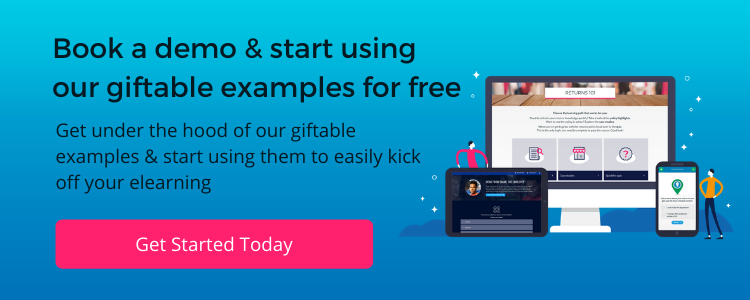What is elearning?
8 minute read
Elearning is impactful and convenient, providing an array of benefits to both users and organizations. Development, technical improvement, and also better affordability of electronic devices have sparked the acceleration of elearning into the 21st Century. But what exactly is elearning and how can it provide opportunities for your organization?

What is elearning?
Elearning, short for electronic learning, is a structured course or learning experience delivered through digital resources.
The scope of elearning systems are wide-ranging, it can include a ten-minute quiz on your phone to completing a university degree at a distance, and everything in between. There are also numerous elements that can make up an elearning course, including video, quizzes, games, activities, and other interactive elements.
Elearning can be accessed through any kind of electronic device, at any time, and anywhere; making this type of learning very popular.
Elearning history
The popularity of elearning has accelerated over the past few decades and is benefiting organizations across the globe today. It is useful to understand how and why this change has occurred by looking at the past of elearning.
In 1999, Elliot Maisie coined the term ‘elearning’ which sparked the rise in the term’s use and reputation. The rise of elearning has been facilitated by several factors to allow it to become the most popular way of delivering training.
These factors include:
- The rise of the internet – previous to this, many relied on the use of printed manuals, CD-ROMS, and other restrictive methods for learning and training. The rise of the internet allowed for flexibility and increased interactivity for learning, abandoning one-dimensional practices. Resulting in virtual learning environments beginning to truly thrive, with people gaining access to a wealth of online information and elearning opportunities.
- Development of Multimedia – learner engagement improved, compared to traditional learning, as the ability to integrate different elements including images, audio, video, and graphics grew. This has subsequently improved the elearning experience of users.
- Affordable Digital Devices – with the first IBM computer costing the equivalent of $5000 today, the accessibility of computers was low. Today, however, the prices of digital devices of laptops and phones have become more accessible to all, leading to the rise of elearning. Mobile learning has particularly facilitated the growth of elearning as it is easier for individuals to learn about particular subjects and develop skills.
- Well-Built Learning Management Systems (LMS) – the LMS concept emerged directly from the rise of elearning. Many LMSs are now highly sophisticated allowing organizations to execute various forms of training. This has been seen through the movement from locally installed to cloud-based systems.

Since these developments, learning methods have adapted further to keep pace with an increasingly digital world; particularly since the pandemic. Due to the need to work from home, more traditional learning methods, such as face-to-face teaching, have had to adjust and move online.
This increased reliance on elearning has highlighted its value and importance, and has particularly shown that people are still willing to learn, despite living in an ever-changing environment.
Types of elearning
Elearning is used to train users to learn a new skill, increase knowledge in a certain area, or complete compliance training.
Elearning does not always stand alone, however, as blended learning allows the combination of traditional classroom-based learning methods with online learning, to create a more dynamic learning experience.
Elearning can also come in the form of distance learning, which refers to any style of learning that is carried out remotely without regular face-to-face interaction. Staff or learners are further apart geographically, which is typically favored by universities and students.
Online learning/training, similar to elearning (an umbrella term), is an entirely virtual method of delivering everything from lectures to work documents to webinars. A higher education institution, for example, will use an LMS to facilitate online learning. This can take the form of asynchronous learning where students are not required to be online at the same time, and utilize discussion threads and emails to complete assignments or synchronous learning where students must be online at the same time.
Digital Learning is a broader term used to define any learning/training that takes place on digital devices. It encompasses the application of a wide spectrum of practices, including blended and virtual learning. It requires a combination of technology, digital content, and instruction.
Microlearning
Microlearning is a way of delivering content to learners in short and digestible bursts, often at the point of need. It can take various forms, from text to an interactive, but the key is to make it short with a focused and specific learning outcome.
It works well for learning on the job, at a moment of need, and as part of spaced learning, where users build up their learning over time through a series of microlearning topics. It can help drive long-term behavior changes in this context.
Gamification
Gamification is the practice of applying gaming formats and tactics to boost participation and engagement in elearning activities. Gamification can help to make elearning more enjoyable, immersive, and accessible, resulting in higher uptake and ongoing participation.
Gamification is not just restricted to quizzes or polls. It can be as simple or as complex as you like, from quick-fire question rounds to gamified scenario-based simulations.
Ultimately the key aim is to grab and keep the attention of your learners and motivate them to get involved.
Elearning Systems
Authoring tools are used to create effective, engaging elearning courses. Authoring tools allow organizations to meet their elearning objectives by…
- Allowing you to personalize your content and adopt a people-centered approach to learning.
- Enables you to collaborate with your team effectively, allowing authors, SMEs, and stakeholders to work together seamlessly.
- Makes it easy to roll out elearning courses in different locations and update content to comply with new regulations quickly and with ease.
Authoring tools can be utilized in a variety of ways to provide impact such as for compliance training, retail training, sales training, and employee upskilling. An elearning system enables organizations to produce engaging, digestible elearning material at scale, and quickly.
LMS
A Learning Management System is built to meet organizational needs, by allowing you to effectively and efficiently create, roll out and manage learning and development. LMS platforms help organizations to keep track and stay compliant, create consistency at scale and use time more effectively for users.
A popular type of LMS is one that is SCORM-compliant. SCORM stands for Shareable Content Object Reference Model. This is a way of setting up an elearning course so that it can run from any SCORM-compliant LMS.
Benefits of elearning
Creating elearning presents businesses and users with a long list of opportunities to take your L&D to the next level.
- It is scalable – any content created can reach all for no extra cost, meaning that you can onboard employees faster, meet compliance regulations more quickly, and increase productivity and performance at scale.
- It is targeted – elearning enables you to produce personalized or adaptive solutions that can target an individual user’s role, needs, and skills gaps. Modern elearning can respond to how an individual interacts with content and/or how they score in questions. For example, by providing specific learning or signposting them to some useful steps to take to expand their experience.
- It is empowering – the opportunity for workplace learning and development is the #1 reason people want to work at an organization as technology puts learning and development in the hands of your end users. Corporate elearning helps to boost the hiring and retention of talent by providing helpful and ‘open’ solutions to personal development.
- It is always available – people learn on multiple electronic devices, wherever and whenever they can. Digital learning is always on and it can be delivered in bite-size pieces that allow it to be used flexibly. With the average employee having just 20 mins a week for workplace learning, digital solutions let you think outside the box on how you can best help busy people develop their skills.
- It is localized – digital learning can easily be adapted and translated to meet the localized needs of global and varied audiences. You can enhance how learning interventions and performance-supporting content reaches and engages wide audiences in relevant and meaningful ways. To achieve this you should opt for technologies that enable you to easily swap out elements, be delivered in multiple languages, and provide personalized pathways.
What are the 4 stages of elearning?
Before you decide which tool is right for you, it’s a smart idea to first define your process of how you will create elearning. Creating effective elearning courses involves several stages that must be carefully planned and executed – and your chosen elearning authoring tool should support you every step of the way.
Let’s take a look at the 4 key stages of elearning development:
- Planning and Analysis: This stage involves identifying the learning goals and objectives, analyzing the target audience, and defining the scope of the course. It’s important to start with a clear plan to get clarity on your learners’ needs. This free guide can help you do just that.
- Design and Development: Once the planning and analysis stage is complete, you should start building your project in your authoring platform. Be sure to get your visual styles in place, collaborate smartly and test your process. This guide will show you how to streamline up your creation process.
- Implementation and Delivery: Once your elearning is developed and tested, it’s now ready to be released to your learners. The course is uploaded to a learning management system (LMS), or can be released via an online URL link, and learners are provided with access to the course. Learners may take the course at their own pace, or there may be a set schedule for taking the course.
- Evaluation and Maintenance: The best learning professionals are using data to improve projects and inform future strategy, and so should you. At this stage, be sure to tap into data dashboards and identify where your content could be tweaked to improve engagement.
How Elucidat fits
Elucidat provides a fully cloud-based authoring platform designed to allow any user to produce impactful online learning, on a global scale, on any device. Learning teams in the world’s most successful organizations are using Elucidat to work collaboratively and efficiently to generate real business impact through elearning, so you can keep up with high demand and business change.
Book a tailored demo today and we will show you how we can help you solve your biggest digital learning challenges.




